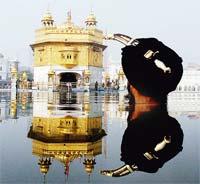A guide to the holy shrines in Sikhdom

Northern India cradles most of the Gurdwaras, worship places of the Sikhs. Here are some of them:
The Golden Temple Amritsar
The Golden Temple is the most sacred place of worship for Sikhs. In its architecture are included symbols associated with other places of worship. This is an example of the spirit of tolerance that the Sikh philosophy propounds.
Akal Takht — Built by the Sixth Guru Hargobind Singh Ji in 1609, it has been the nerve centre of Sikhism ever since. All commandments affecting the community are issued from here. A number of weapons used by Guru Hargobind, Guru Gobind Singh and other Sikh heroes are preserved at the Akal Takht.
Baba Atal — A nine-storeyed tower, built in memory of Atal Rai (D. 1628), a son of Hargobind, was built between 1778 and 1784. It is the only one of its kind in Amritsar.
Guru Ka Langar — A Sikh temple without a community kitchen is inconceivable. Cooked food is served in the kitchen of the Golden Temple 24 hours a day to all visitors irrespective of religion, caste, creed and nationality. The expenses are met out of Temple funds. Approximately 40,000 visitors share the meals every day at present.
Sri Guru Ram Das Niwas — The Niwas is a free hostel for the pilgrims maintained by the Golden Temple authorities. The Gurdwara Committee built it. It has 228 rooms and 18 big halls. The doors of the hostels are open to all.
The SGPC Offices — The headquarters of the Shiromani Gurdwara Parbandhak Committee are located in the Teja Singh Samundri Hall near the Golden Temple.
In addition to the Akal Takht or Eternal Throne, there are four other thrones which have very special significance. They are considered the seats of Sikh religious authority.
Takht Sri Keshgarh Sahib
Guru Gobind Singh founded the Khalsa order here in 1699. Some of his weapons are displayed here. The most precious is the Khanda (double-edged sword) used by Guru Gobind Singh to prepare the amrit (sweet water) used in the first Khalsa initiation ceremony.
Takht Sri Hazur Sahib
On the banks of Godavari in Maharashtra, it’s where Guru Gobind Singh left this world. The inner room is called Angitha Sahib and is built over the place where Guru Gobind Singh was cremated in 1708.
Takht Sri Damdama Sahib
Situated in the village of Talwandi Sabo near Bhatinda, it’s where Guru Gobind Singh stayed for nearly a year and compiled the final edition of the Guru Granth Sahib known as the Damdama Sahib Bir in 1705.
Takht Sri Patna Sahib
Situated in Patna, the capital of Bihar, Guru Gobind Singh was born here in 1666 and spent his early years before moving to Anandpur. Besides being the birthplace of Guru Gobind Singh, Patna was also honoured by visits from Guru Nanak as well as Guru Tegh Bahadur.









